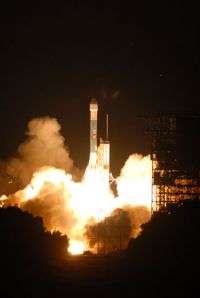Phoenix Heads for Mars

A Delta II rocket lit up the early morning sky over Cape Canaveral Air Force Station in Florida as it carried the Phoenix spacecraft on the first leg of its journey to Mars. The powerful three-stage rocket with nine solid rocket motors lifted off at 5:26 a.m. EDT.
The Phoenix Mars lander's assignment is to dig through the Martian soil and ice in the arctic region and use its onboard scientific instruments to analyze the samples it retrieves.
Just as NASA's Mars rovers, Spirit and Opportunity, captured the imagination of old and young alike as they explored the Martian surface, a new space explorer is waiting in the wings to take center stage: the Mars lander called Phoenix.
Phoenix will travel 679 million kilometers (422 million miles) in an outward arc from Earth to Mars. It will determine whether icy soil on far northern Mars has conditions that have ever been suitable for life.
Phoenix's scientific work will be directed by a group from the University of Arizona, led by Principal Investigator Peter Smith. What discoveries NASA and Smith's team will uncover is hard to predict but, once again, the mysteries of the red planet have the potential to captivate an Earth-bound audience.
Mars is a cold desert planet with no liquid water on its surface. But in the Martian arctic, water ice lurks just below ground level. Discoveries made by the Mars Odyssey Orbiter in 2002 show large amounts of subsurface water ice in the northern arctic plain. The Phoenix lander targets this circumpolar region using a robotic arm to dig through the protective top soil layer to the water ice below and ultimately, to bring both soil and water ice to the lander platform for sophisticated scientific analysis.
The complement of the Phoenix spacecraft and its scientific instruments are ideally suited to uncover clues to the geologic history and biological potential of the Martian arctic. Phoenix will be the first mission to return data from either polar region providing an important contribution to the overall Mars science strategy "Follow the Water" and will be instrumental in achieving the four science goals of NASA's long-term Mars Exploration Program.
--Determine whether Life ever arose on Mars
--Characterize the Climate of Mars
--Characterize the Geology of Mars
--Prepare for Human Exploration The Phoenix Mission has two bold objectives to support these goals, which are to (1) study the history of water in the Martian arctic and (2) search for evidence of a habitable zone and assess the biological potential of the ice-soil boundary.
Source: NASA





















